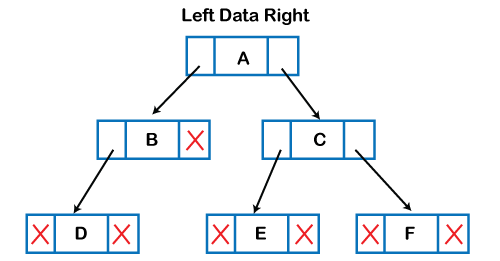TREE
In linear data structure data is organized in sequential order and in non-linear data structure data is organized in random order. A tree is a very popular non-linear data structure used in a wide range of applications. A tree data structure can be defined as follows...
Tree is
a non-linear data structure which organizes data in hierarchical structure and
this is a recursive definition.
A tree data structure can also be defined as follows...
Tree data
structure is a collection of data (Node) which is organized in hierarchical
structure recursively
In tree data
structure, every individual element is called as Node. Node in a tree
data structure stores the actual data of that particular element and link to
next element in hierarchical structure.
In a tree data structure, if we have N number of nodes
then we can have a maximum of N-1 number of
links.
Example
Let's understand some key points of the Tree data structure.
- A tree data structure is defined as a collection of objects or entities known as nodes that are linked together to represent or simulate hierarchy.
- A tree data structure is a non-linear data structure because it does not store in a sequential manner. It is a hierarchical structure as elements in a Tree are arranged in multiple levels.
- In the Tree data structure, the topmost node is known as a root node. Each node contains some data, and data can be of any type. In the above tree structure, the node contains the name of the employee, so the type of data would be a string.
- Each node contains some data and the link or reference of other nodes that can be called children.
Implementation of Tree
The tree data structure can be created by creating the nodes dynamically with the help of the pointers. The tree in the memory can be represented as shown below:

The above figure shows the representation of the tree data structure in the memory. In the above structure, the node contains three fields. The second field stores the data; the first field stores the address of the left child, and the third field stores the address of the right child.
In programming, the structure of a node can be defined as:
The above structure can only be defined for the binary trees because the binary tree can have utmost two children, and generic trees can have more than two children. The structure of the node for generic trees would be different as compared to the binary tree.
Applications of trees
The following are the applications of trees:
- Storing naturally hierarchical data: Trees are used to store the data in the hierarchical structure. For example, the file system. The file system stored on the disc drive, the file and folder are in the form of the naturally hierarchical data and stored in the form of trees.
- Organize data: It is used to organize data for efficient insertion, deletion and searching. For example, a binary tree has a logN time for searching an element.
- Trie: It is a special kind of tree that is used to store the dictionary. It is a fast and efficient way for dynamic spell checking.
- Heap: It is also a tree data structure implemented using arrays. It is used to implement priority queues.
- B-Tree and B+Tree: B-Tree and B+Tree are the tree data structures used to implement indexing in databases.
- Routing table: The tree data structure is also used to store the data in routing tables in the routers.
